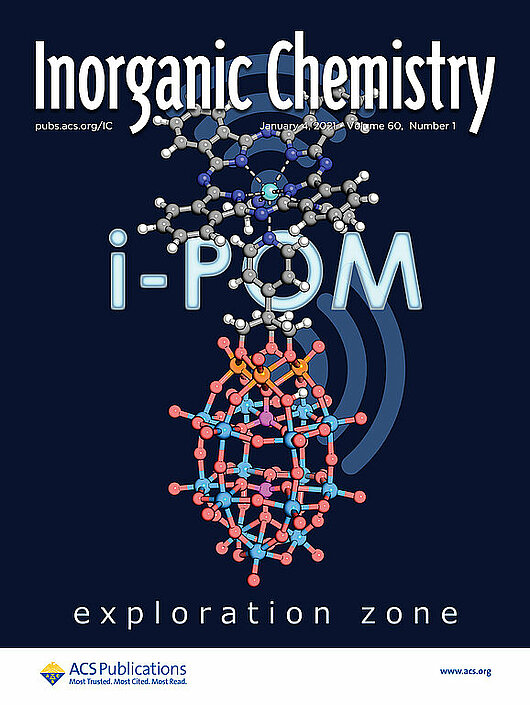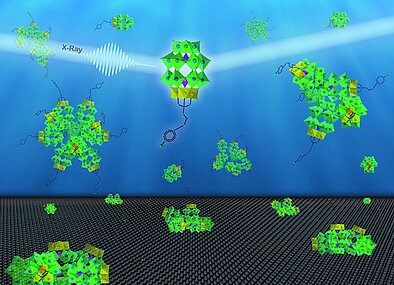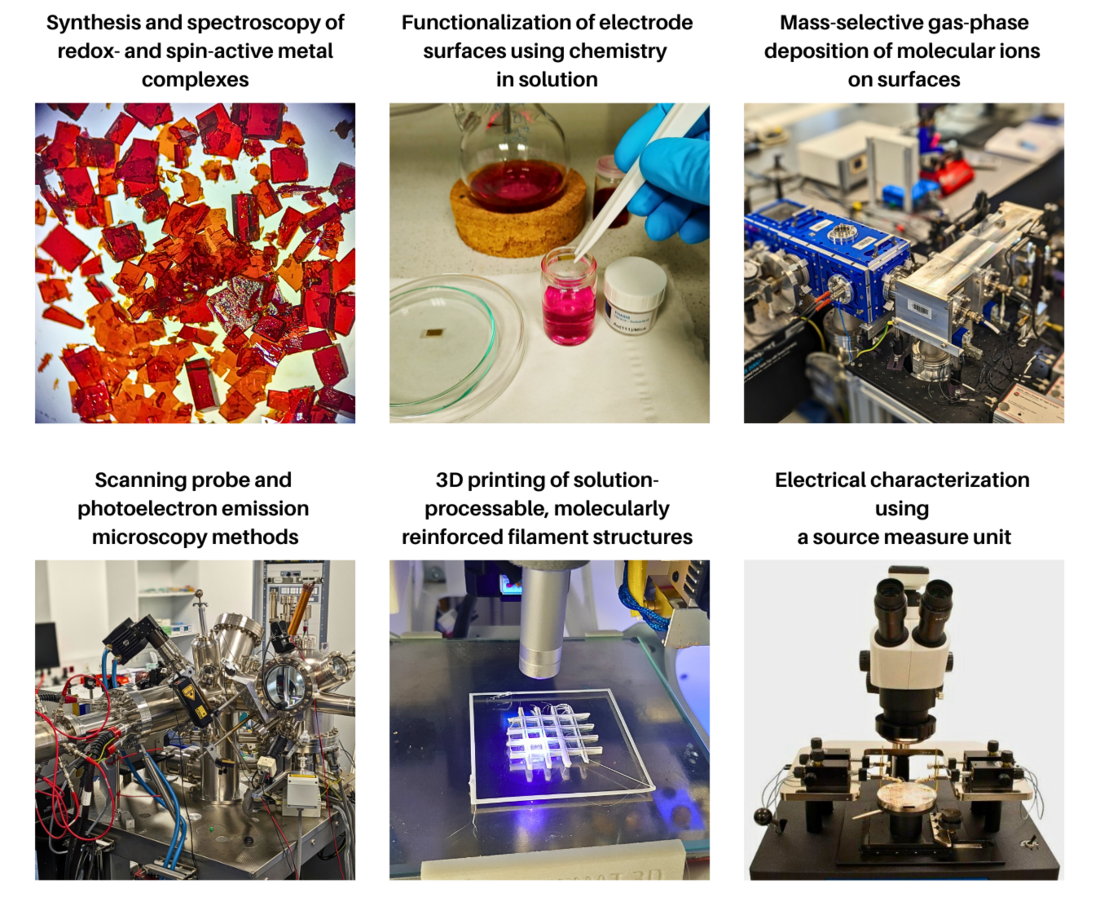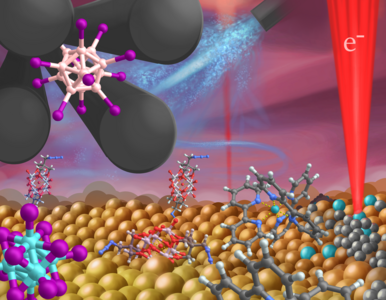"Explorative Projects" as an incubator is a development space, where two working groups "Switchable molecularly functionalized surfaces" (leader: Dr. Kirill Monakhov) and "Surface engineering with mass-selected molecular ions" (leader: Dr. Jonas Warneke, Joint Lab together with the Leipzig University) develop future-oriented, molecular-based material concepts for resource-efficient information and sensor technologies as well as carry out the necessary surface modification with mass-selected molecular ions and their composition analysis down to the submicroscopic level. The incubator's transdisciplinary projects relate to subject areas that use and expand the IOM's core competencies and thus contribute to increasing the innovative strength of the Free State of Saxony in the MINT sector and to achieving the United Nations' development goals (especially Goal 9).
Highlights
On-surface single-molecule identification of mass-selected cyclodextrin-supported polyoxovanadates for multistate resistive-switching memory applications
F. Yang, M. Moors, D. Hoang, S. Schmitz, M. Rohdenburg, H. Knorke, A. Charvat, X.-B. Wang, , K. Y. Monakhov, J. Warneke
ACS Appl. Nano Mater. 2022, 5, 14216–14220
https://pubs.acs.org/doi/10.1021/acsanm.2c03025Hybrid molecular magnets with lanthanide- and counter-cation-mediated interfacial electron transfer between phthalocyanine and polyoxovanadate
I. Werner, J. Griebel, A. Masip-Sánchez, X. López, K. Załęski, P. Kozłowski, A. Kahnt, M. Boerner, Z. Warneke, J. Warneke, K. Y. Monakhov
Inorg. Chem. 2023, 62, 3761–3775
https://pubs.acs.org/doi/10.1021/acs.inorgchem.2c03599Solution-processable molecular oxides for integrated memories
K. Y. Monakhov, M. Moors, E. Vogelsberg, J. Lorenz, J. Warneke, F. Yang
2023 IEEE International Interconnect Technology Conference (IITC) and IEEE Materials for Advanced Metallization Conference (MAM)(IITC/MAM), Dresden, Germany, 2023, pp. 1–3
https://ieeexplore.ieee.org/document/10154863Insights from Adsorption and Electron Modification Studies of Polyoxometalates on Surfaces for Molecular Memory Applications

M. Moors, J. Warneke, X. López, C. de Graaf, B. Abel, K. Y. Monakhov
Acc. Chem. Res. 2021, 54, 3377–3389
https://pubs.acs.org/doi/10.1021/acs.accounts.1c00311This Account highlights recent experimental and theoretical work focusing on the development of polyoxometalates (POMs) as possible active switching units in what may be called “molecule-based memory cells”. Herein, we critically discuss how multiply charged vanadium-containing POMs, which exhibit stable metal–oxo bonds and are characterized by the excellent ability to change their redox states without significant structural distortions of the central polyoxoanion core, can be immobilized best and how they may work optimally at appropriate surfaces. Furthermore, we critically discuss important issues and challenges on the long way toward POM-based nanoelectronics. This Account is divided into four sections shedding light on POM interplay in solution and on surfaces, ion soft-landing of mass-selected POMs on surfaces, electronic modification of POMs on surfaces, and computational modeling of POMs on surfaces. The sections showcase the complex nature of far-reaching POM interactions with the chemical surroundings in solution and the properties of POMs in the macroscopic environment of electrode surfaces. Section 2 describes complex relationships of POMs with their counter-cations, solvent molecules, and water impurities, which have been shown to exhibit a direct impact on the resulting surface morphology, where a concentration-dependent formation of micellar structures can be potentially observed. Section 3 gives insights into the ion soft-landing deposition of mass-selected POMs on electrode surfaces, which emerges as an appealing method because the simultaneous deposition of agglomeration-stimulating counter-cations can be avoided. Section 4 provides details of electronic properties of POMs and their modification by external electronic stimuli toward the development of multiple-state resistive (memristive) switches. Section 5 sheds light on issues of the determination of the electronic structure properties of POMs across their interfaces, which is difficult to address by experiment. The studies summarized in these four sections have employed various X-ray-scattering, microscopy, spectroscopy, and computational techniques for imaging of POM interfaces in solution and on surfaces to determine the adsorption type, agglomeration tendency, distribution, and oxidation state of deposited molecules. The presented research findings and conceptual ideas may assist experimentalists and theoreticians to advance the exploration of POM electrical conductivity as a function of metal redox and spin states and to pave the way for a realization of (“brain-inspired”) POM-based memory devices, memristive POM-surface device engineering, and energy efficient nonvolatile data storage and processing technologies.
{P2V3W15}-polyoxometalates functionalized with phthalocyaninato Y and Yb moieties

R. Pütt, P. Kozłowski, I. Werner, J. Griebel, S. Schmitz, J. Warneke, K. Y. Monakhov
Inorg. Chem. 2021, 60, 80–86
https://pubs.acs.org/doi/10.1021/acs.inorgchem.0c02257A tris(alkoxo)pyridine-augmented Wells–Dawson polyoxometalate (nBu4N)6[WD-Py] (WD = P2V3W15O59(OCH2)3C, Py = C5H4N) was functionalized with phthalocyaninato metal moieties (MPc where M = Y or Yb and Pc = C32H16N8) to afford (nBu4N)4[HWD-Py(MPc)] compounds. High-resolution mass spectrometry was used to detect and identify the hybrid assembly. The magnetism studies reveal substantial differences between M = Yb (monomeric, single-ion paramagnetism) and M = Y (containing dimers, radical character). The results of electronic paramagnetic resonance spectroscopy, SQUID magnetometry, and magnetochemical calculations indicate the presence of intramolecular charge transfer from the MPc moiety to the polyoxometalate and of intermolecular charge transfer from the MPc moiety of one molecule to the polyoxometalate unit of another molecule. These compounds with identified VIV ions represent unique examples of transition-metal/lanthanide complex-POM hybrid compounds with nonphotoinduced charge transfer between electron donor and acceptor centers.
Synthesis, Structure, and Surface Adsorption Characteristics of a Polynuclear MnII,IV–YbIII Complex
K. Ueltzen, S. Schmitz, M. Moors, M. Glöß, M. Börner, I. Werner, Z. Warneke, J. Warneke, B. Abel, K. Y. Monakhov
Inorg. Chem. 2021, 60, 10415–10425
https://pubs.acs.org/doi/10.1021/acs.inorgchem.1c00994The controlled adsorption of polynuclear coordination compounds with specific structural and electronic characteristics on surfaces is crucial for the prospective implementation of molecule–surface interfaces into practical electronic devices. From this perspective, a neutral 3d,4f-coordination cluster [MnII3MnIVYb3O3(OH)(L·SMe)3(OOCMe)9]·2MeCN·3EtOH (1·2MeCN·3EtOH), where L·SMe– is a Schiff base, has been synthesized and fully characterized and its adsorption on two different solid substrates, gold and graphite, has been studied. The mixed-valence compound with a bilayered metal core structure and the structurally exposed thioether groups exhibits a substantially different surface bonding to metallic gold and semimetallic graphite substrates. While on graphite the adsorption takes place only on distinguished attraction points with a locally increased number of potential bonding sites such as terrace edges and other surface defects, on gold the molecules were found to adsorb rather weakly on randomly distributed adsorption sites of the surface terraces. This entirely different behavior provides important information for the development of advanced surface materials that may enable well-distributed ordered molecular assemblies.



